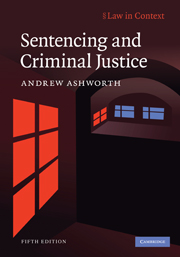Book contents
- Frontmatter
- Contents
- Preface
- Table of legislative measures
- Table of cases
- 1 An introduction to English sentencing
- 2 Sentencing and the constitution
- 3 Sentencing aims, principles and policies
- 4 Elements of proportionality
- 5 Aggravation and mitigation
- 6 Persistence, prevention and prediction
- 7 Equality before the law
- 8 Multiple offenders
- 9 Custodial sentencing
- 10 Non-custodial sentencing
- 11 Procedural issues and ancillary orders
- 12 Special sentencing powers
- 13 Conclusions
- Appendix: The Sentencing Council: provisions in the Coroners and Justice Act 2009
- References
- Index
5 - Aggravation and mitigation
Published online by Cambridge University Press: 05 June 2012
- Frontmatter
- Contents
- Preface
- Table of legislative measures
- Table of cases
- 1 An introduction to English sentencing
- 2 Sentencing and the constitution
- 3 Sentencing aims, principles and policies
- 4 Elements of proportionality
- 5 Aggravation and mitigation
- 6 Persistence, prevention and prediction
- 7 Equality before the law
- 8 Multiple offenders
- 9 Custodial sentencing
- 10 Non-custodial sentencing
- 11 Procedural issues and ancillary orders
- 12 Special sentencing powers
- 13 Conclusions
- Appendix: The Sentencing Council: provisions in the Coroners and Justice Act 2009
- References
- Index
Summary
Some preliminary problems of principle
The concepts of aggravation and mitigation have tended to attract little close examination or theoretical discussion. Perhaps this is because the factors recognized as aggravating or mitigating are thought to be uncomplicated or uncontroversial, or (in the terminology of the English judiciary) ‘well known’ and ‘well established’. However, it will be argued in this chapter that many of them raise contentious issues. These issues assume particular importance now for four reasons:
several aggravating factors and one mitigating factor are statutory requirements under the Criminal Justice Act 2003, as we shall see;
s. 166 of the 2003 Act reaffirms that the various statutory thresholds for imposing custodial sentences and community sentences should not be read as ‘prevent[ing] a court from mitigating an offender's sentence by taking into account such matters as, in the opinion of the court, are relevant in mitigation of sentence’; and
s. 174(2) of the 2003 Act requires the court in any case to ‘mention any aggravating or mitigating factors which the court has regarded as being of particular importance’; and
most sentencing decisions are now covered by guidelines, either from the SGC or from the Court of Appeal: many guidelines indicate the significant aggravating and mitigating factors for the relevant offence(s), and some guidelines label such factors as ‘determinants of seriousness’ to distinguish between the various sentence ranges.
For these four reasons, the analysis of the justifications for particular aggravating and mitigating factors becomes a more pressing task than may hitherto have been supposed.
- Type
- Chapter
- Information
- Sentencing and Criminal Justice , pp. 156 - 194Publisher: Cambridge University PressPrint publication year: 2010
- 1
- Cited by

